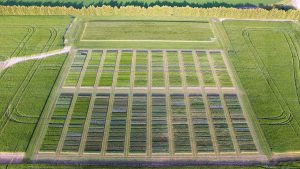Interseeding cover crops
RESEARCH AT THE HRDC

RESEARCH SCIENTISTS AT Agriculture and Agri-Food Canada’s (AAFC) Harrow Research & Development Centre (HRDC) have been exploring several angles of how cover crops can benefit both the environment and a farming operation.
“Cover crops introduce carbon, recycle nutrients, and prevent surface run-off and leaching,” says Dr. Xueming Yang, a research scientist at the HRDC, adding that cover crops can also potentially help control soil erosion, improve soil structure, increase soil organic matter, suppress weeds, and disrupt pest and disease cycles.
“Using cover crops introduces a whole biological process, year-round, even during the non-crop season, that is really good for the soil and the environment,” he explains.
Specific to preserving water quality, Yang says cover crops play a crucial role in the remediation of excess soil nutrients, such as nitrogen and phosphorus, that can damage water quality, particularly in the late fall and in early spring when a substantial amount of leaching occurs. It’s this, he says, that has farmers in the Great Lakes region particularly eager to use living cover crops to cover the ground after harvesting their corn.
EFFECTIVENESS
But as scientists at the HRDC are discovering, how and when you seed a cover crop also plays an extremely important role in how effective the cover crop can be.
“Broadcasting cover crop seeds on the soil surface, with no seed incorporation during the growth of crops, generally results in poor germination,” says Yang. “And, cover crops sown after corn harvest often not only establish poorly, but also have little time for growth before winter sets in, and often winter-kill.”
But his preliminary research has shown that interseeding the cover crop early — that is, planting one or more cover crop species into an existing crop early in the season — has produced much better results.
Yang says in his latest 2016 – 2017 research, the goal was to explore the results of interseeding different legume cover crops with corn. Crimson clover, red clover, and hairy vetch were sown into the field between the corn rows early in the season, generally when the corn was at the six or seven leaf stage.
OBSERVATIONS
He observed that while cover crops provided competition against weeds, there was little competition to the corn. This was evidenced, he says, by minimized cover crop biomass accumulation during the corn phase and with good corn yield in both years—about 210 bushels/acre, with no difference in corn yields between the corn crop sown with an interseeded cover crop versus the corn without cover crop.
In a general sense, Yang also observed that while all three legume cover crops worked, he discovered that hairy vetch seemed to produce the best results, and that the crimson clover wasn’t as winter-hardy during overwintering.
Still, Yang says while the overall results of interseeding cover crops into corn were impressive, there are “many issues that need to be evaluated to optimize the potential of cover crops in the future.”
Moving forward, he will be looking at cover crops from a nutrient point of view and, in particular, how much nitrogen residual remains for the following crop years.
“We know by using a legume cover crop there will be nutrients there, but we’d like to know precisely how it benefits other crops, especially the nitrogen benefit to crops,” explains Yang, adding that he’d also like to study how to more precisely achieve the best balance of maximum crop yield with cover crop benefits. l
BUILDING AN INTERSEEDER
To help research at Agriculture and Agri-Food Canada’s Harrow Research & Development Centre (HRDC) explore the benefits of cover crops, the centre developed an interseeding machine to help sow their fields.
Dr. Xueming Yang, a research scientist with the HRDC, says the interseeder was built in the HRDC’s workshop. He says the seeder, a PS120 MI from APV (www.apv.at), and toolbar were attached to a steel frame and the monitoring system was attached to the tractor. The toolbar is a double 4” x 4” steel frame with three wavy coulters to go between 30” rows attached with a three-point hitch.
Yang says they interplanted cover crops between four rows of corn at a time with two air seeder outlets per row. The wavy coulters, he explains, mix the seeds with the soil.
Yang says that while it is fairly basic in its design, it produces fantastic results.
He believes that most farmers already have heard and understand the idea that cover crops can bring big benefits to the soil, the environment, and improve the economics of their operation. But as Yang says — it has to be done properly.
“Surface broadcasting doesn’t produce good results — it’s not consistent,” he says. “Interseeding cover crops into the main crop produces much better results.” •
























